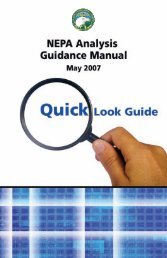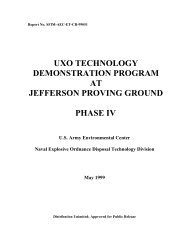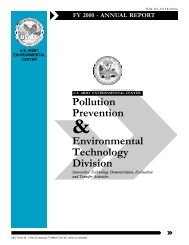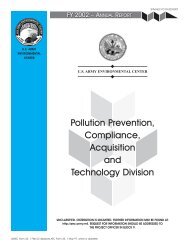(MRAP) Vehicle Program - U.S. Army Environmental Center
(MRAP) Vehicle Program - U.S. Army Environmental Center
(MRAP) Vehicle Program - U.S. Army Environmental Center
Create successful ePaper yourself
Turn your PDF publications into a flip-book with our unique Google optimized e-Paper software.
<strong>Army</strong> <strong>MRAP</strong> <strong>Vehicle</strong> <strong>Program</strong> <strong>Program</strong>matic <strong>Environmental</strong> Assessment December 2010<br />
RG33 CAT I Cummins ISL, 8.9L 400 Euro 3<br />
RG33 CAT II Cummins ISL, 8.9L 400 Euro 3<br />
HAGA CAT II Cummins ISL, 8.9L 400 Euro 3<br />
Caiman Caterpillar C‐7, 7.2L 330 EPA 2004 On‐highway*<br />
MaxxPro International DT530 engine 300 EPA 1998 On‐highway<br />
M‐ATV Caterpillar C‐7, 7.2L 330 EPA 2004 On‐highway<br />
*Only the first 1,192 vehicles have EPA 2004 certified engines. At that point the engine was recalibrated<br />
to meet performance requirements and is no longer EPA certified. However, the engine is exempt from<br />
EPA emission standards as discussed above.<br />
5.4.1 Production<br />
Prior to applying paint primers and topcoats to the <strong>MRAP</strong> vehicles, contractor personnel<br />
apply a chemical metal pretreatment or use abrasive blasting techniques on the <strong>MRAP</strong><br />
vehicle hull. Table 7 contains a listing of pretreatments used on each <strong>MRAP</strong> variants’<br />
hull. The application of the pretreatments occurs in permitted paint booths using spray<br />
applications, and the abrasive blasting occurs in permitted blast booths.<br />
During painting activities, contractor personnel apply interior/exterior paint primers and<br />
interior topcoats and exterior Chemical Agent Resistant Coating (CARC) topcoats using spray<br />
applications. Table 7 lists the types of primers and topcoats. These coatings contain various<br />
volatile solvents, and some of these solvents are listed as Volatile Organic Compounds<br />
(VOCs) and Hazardous Air Pollutants (HAPs). These primers and topcoats comply with<br />
current content regulations. Table 8 contains a listing of the primers’ and coatings’ VOC<br />
and HAP limits as defined by the specifications. The VOC and HAP content of these primers<br />
and topcoats remain at or below current US EPA requirements.<br />
The spray application of wash primers, pretreatments, paint primers and topcoats takes<br />
place in permitted paint booths. These paint booths are included within the facilities’ air<br />
emission discharge permits. The paint booths contain the necessary pollution abatement<br />
equipment to minimize air emissions as well as contain fugitive emissions.<br />
Table 7. Primers and Topcoats Applied to <strong>MRAP</strong> Variants<br />
Variant Hull<br />
Interior Primers Interior Exterior Exterior CARC<br />
Pretreatment<br />
Topcoat Primer<br />
Caiman Abrasive Blast MIL‐P‐53030 MIL‐C‐22750 A‐A‐59745 MIL‐P‐53039,<br />
and MIL‐P‐53022<br />
Type I<br />
MaxxPro DoD‐P‐15328 MIL‐P‐53022 MIL‐C‐22750 MIL‐P‐53022 MIL‐P‐53039,<br />
Type I<br />
RG33 AquaZen Wash MIL‐P‐53030 MIL‐C‐22750 MIL‐P‐53030 MIL‐P‐53039,<br />
Primer<br />
Type I<br />
Cougar/Buffalo Bonderite 7400 MIL‐P‐53022 MIL‐C‐22750 MIL‐P‐53022 MIL‐P‐53039,<br />
Type I<br />
UNCLASSIFIED 28







